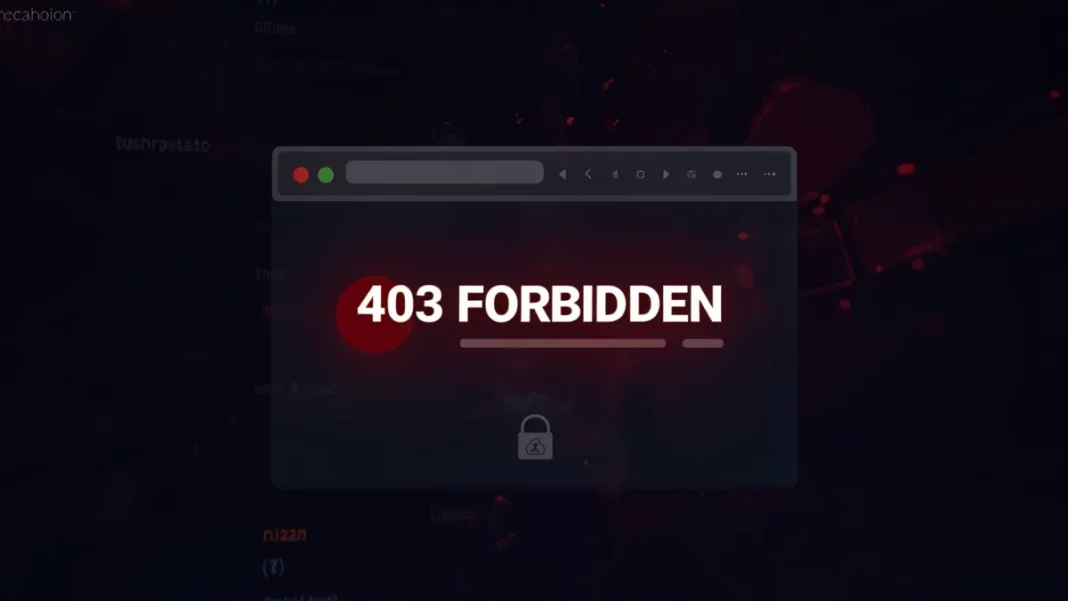403 forbidden errors can halt your browsing experience abruptly. Have you ever been denied entry to a website you desperately needed? Like a locked door with no key, these errors leave you wondering, “What did I do wrong?” In this article, you’ll uncover the secrets behind error 403, learn practical fixes and understand how to prevent them from happening again.
Understanding the 403 Forbidden Error
- The 403 forbiden error signifies that the server understands your request, but it refuses to authorize it. Essentially, it’s like a bouncer at a club who says, “Sorry, you’re not on the list.” This happens when your browser doesn’t have the necessary permissions to access the requested resource.
- The http 403 code is a standard HTTP status code indicating this specific type of access denial.
- This rejection can stem from various reasons, like incorrect file permissions, misconfigured server settings, or even simple typos in the URL. Recognizing the root cause of the 403 error issue is the first step toward resolving it.
- A common misconception is that a 403 forbiden erro 403 is always the user’s fault. However, it often points to a server-side problem.
Common Causes of a 403 Forbidden Error
Incorrect File Permissions:
- Server files have specific permissions that dictate who can access them. If these permissions are set incorrectly, the server might block your access.
- For instance, if a file’s permissions are set to read-only for the server owner and you’re not the owner, you’ll encounter a 403 forbiden message.
- This is a frequent cause of the error 403 when working with website file uploads.
- One must ensure that file permissions are set correctly.
Misconfigured .htaccess Files: 403 Forbidden
- The .htaccess file controls various server settings. If this file contains incorrect directives, it can lead to a 403 forbiden error.
- A single typo in this file can wreak havoc, blocking access to your entire website.
- When troubleshooting the 403 forbiden error, always check the .htaccess file.
- This file is a powerful tool, but also a source of many 403 forbiden troubles.
Incorrect IP Addresses: 403 Forbidden
- Sometimes, servers are configured to restrict access based on IP addresses. If your IP address is blocked, you’ll see a 403 forbiden notification.
- This can happen due to security measures or accidental blocking by the server administrator.
- Often, VPN usage can cause this issue, so checking without a VPN is a good step.
- IP blocking is a serious cause of the http 403 error.
How to Fix a 403 Forbidden Error (Client-Side)
Check the URL:
- A simple typo in the URL can lead to a 403 forbiden error. Double-check the URL to ensure it’s correct.
- Pay attention to capitalization and special characters. Sometimes, the server is case-sensitive.
- A small error can lead to a large 403 forbiden problem.
- Always begin with the simplest solution, checking the url.
Clear Browser Cache and Cookies: 403 Forbidden
- Outdated or corrupted browser data can sometimes cause conflicts. Clearing your cache and cookies might resolve the issue.
- This action forces your browser to fetch fresh data from the server.
- Clearing your cache is a standard step in fixing the 403 forbiden issue.
- This is a very common fix for multiple web related problems.
Try a Different Browser: 403 Forbidden
- If the problem persists, try accessing the website using a different browser. This helps determine if the issue is browser-specific.
- Sometimes browser extensions can cause issues that leads to the 403 forbiden error.
- This is a good way to determine if the issue is local, or server based.
- Testing with different browsers can isolate the issue.
How to Fix a 403 Forbidden Error (Server-Side)
Adjust File Permissions:
- If you have access to the server, ensure that the file permissions are correctly set. This often involves using an FTP client or a file manager.
- Typically, file permissions should be set to 644 for files and 755 for directories.
- Incorrect file permissions are a frequent cause of the 403 forbiden notification.
- This is a critical step for server administrators.
Check .htaccess Configuration:
- Review the .htaccess file for any incorrect directives. If you’re unsure, try renaming the file temporarily to see if it resolves the issue.
- Backup this file before making any changes. A small error can cause a 403 forbiden error.
- This file is very powerful and needs to be handled with care to prevent the 403 forbiden problem.
- Carefully review the .htaccess file.
Contact Your Hosting Provider: 403 Forbidden
- If you’ve tried all the client-side and server-side fixes and the problem persists, contact your hosting provider. They can help diagnose and resolve server-related issues.
- They have access to server logs and can provide insights into the root cause of the 403 forbiden error.
- Hosting providers are a good resource when all other fixes have failed to resolve the error 403.
- They are the experts when it comes to server side issues.
Conclusion:
The 403 forbidden error can be frustrating, but understanding its causes and knowing how to troubleshoot it can save you time and stress. Whether it’s a simple URL typo or a complex server configuration issue, the solutions outlined in this article should help you regain access to the website. Remember to start with the simplest fixes and work your way up to more complex solutions. By following these steps, you can effectively resolve error 403 and ensure a smoother browsing experience.
FAQs:
What does a 403 forbidden error mean?
It means the server understood your request but refused to authorize it.
Can you fix a 403 forbiden error by yourself?
Yes, you can try client-side fixes like checking the URL and clearing your cache. However, server-side fixes might require server access.
How to check file permissions to fix a 403 forbiden error?
You can use an FTP client or a file manager provided by your hosting provider to view and modify file permissions.
Is a 403 forbiden error always your fault?
No, it can be caused by server-side issues beyond your control.
Could a VPN cause a 403 forbiden error?
Yes, sometimes VPN’s cause IP address conflicts that lead to the 403 forbiden error.
What is a .htaccess file and how does it relate to 403 forbiden errors?
The .htaccess file is a server configuration file. Incorrect configurations within it can trigger a 403 forbiden response.
If all else fails, who should you contact about a 403 forbiden error?
Contact your hosting provider for server-side assistance.
Also Read: Telegram Group Link: Tips to Join, Chat & Connect
David William comes from an Engineering background, with a specialization in Information Technology. He has a keen interest and expertise in Web Development, Data Analytics, and Research. He trusts in the process of growth through knowledge and hard work.


